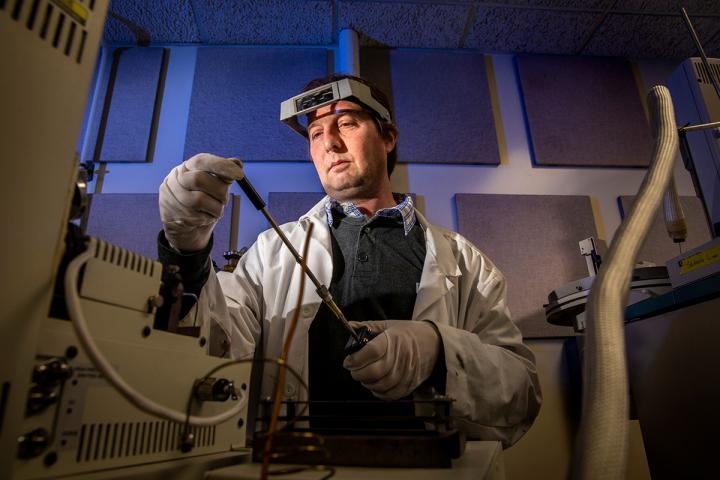Jan 28 2019
The world’s surface waters are being contaminated with microplastics, but despite this fact, researchers have only just started to study their presence in groundwater systems.
 Illinois Sustainable Technology Center researcher John Scott is part of a team of researchers who are among the first to explore microplastic contamination in groundwater systems. (Image credit: Photo by Fred Zwicky)
Illinois Sustainable Technology Center researcher John Scott is part of a team of researchers who are among the first to explore microplastic contamination in groundwater systems. (Image credit: Photo by Fred Zwicky)
Now, a first-ever study has reported the presence of microplastics in fractured limestone aquifers—a groundwater source that is responsible for 25% of the world’s drinking water supply.
The study detected microplastic fibers, together with a wide range of household contaminants and medicines, in two aquifer systems located in Illinois. The results of the study have been reported in the journal Groundwater.
Plastic in the environment breaks down into microscopic particles that can end up in the guts and gills of marine life, exposing the animals to chemicals in the plastic. As the plastics break down, they act like sponges that soak up contaminants and microbes and can ultimately work their way into our food supply.
John Scott, Study Co-Author and Researcher, Illinois Sustainable Technology Center
Groundwater generally flows through the voids and cracks in limestone, at times carrying runoff and sewage from agricultural areas, roads, and landfills into the underneath aquifers, stated Scott.
For their study, the scientists obtained 17 groundwater samples from springs and wells—6 samples from an aquifer containing relatively smaller fractured limestone in rural northwestern Illinois and 11 samples from a highly fractured limestone aquifer close to the St. Louis metropolitan area.
The study revealed that microplastic particles were present in all except one of the 17 samples, with the highest concentration of 15.2 particles per liter detected from a spring located in the St. Louis area. Conversely, it is difficult to figure out what exactly that concentration means, informed Scott. And added to this, no published risk assessment regulations or studies are available.
However, the scientists did find that concentrations from their field area are similar to the concentrations of surface water found in the streams and rivers located in the Chicago area, stated Samuel V. Panno, lead author of the study and an Illinois State Geological Survey researcher.
The research on this topic is at a very early stage, so I am not convinced we have a frame of reference to state expectations or bounds on what is considered low or high levels. Our questions are still basic—how much is there and where is it coming from?
Tim Hoellein, Study Co-Author and Biology Professor, Loyola University Chicago
An assortment of household and personal health contaminants, together with the microplastics, was identified by the researchers, indicating that the fibers could have come from household septic systems.
“Imagine how many thousands of polyester fibers find their way into a septic system from just doing a load of laundry,” stated Scott. “Then consider the potential for those fluids to leak into the groundwater supply, especially in these types of aquifers where surface water interacts so readily with groundwater.”
Scott added that more extensive studies need to be performed on this topic, and expects that microplastic contamination in groundwater as well as surface water will be a significant issue in the coming years.
Even if we quit plastics cold turkey today, we will still deal with this issue for years because plastic never really goes away. It is estimated that 6.3 billion metric tons of plastic waste have been produced since the 1940s, and 79 percent of that is now in landfills or the natural environment. To me, it is such a weird concept that these materials are intended for single use, yet they are designed to last forever.
John Scott, Study Co-Author and Researcher, Illinois Sustainable Technology Center
Other researchers who contributed to the study are Walton R. Kelly of the Illinois State Water Survey; Wei Zhang and Nancy Holm of ISTC; Rachel E. McNeish of California State University, Bakersfield; Timothy J. Hoellein of Loyola University, Chicago; and Elizabeth L. Baranski of the League of Women Voters of Jo Daviess County. The ISTC, ISGS, and ISWS are part of the Prairie Research Institute at the University of Illinois at Urbana Champaign.
The study was supported by the League of Women Voters of Jo Daviess County, ISGS, ISWS, ISTC, Illinois-Indiana Sea Grant of the National Oceanic Atmospheric Administration, and the National Science Foundation.